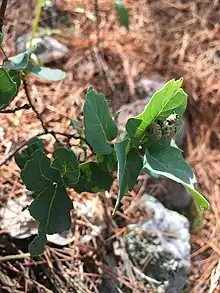| Quercus depressipes | |
|---|---|
 | |
| Scientific classification | |
| Kingdom: | Plantae |
| Clade: | Tracheophytes |
| Clade: | Angiosperms |
| Clade: | Eudicots |
| Clade: | Rosids |
| Order: | Fagales |
| Family: | Fagaceae |
| Genus: | Quercus |
| Subgenus: | Quercus subg. Quercus |
| Section: | Quercus sect. Quercus |
| Species: | Q. depressipes |
| Binomial name | |
| Quercus depressipes | |
| Synonyms[2][3] | |
| |
Quercus depressipes (known as depressed oak[3] and Davis Mountain oak[1]) is a species of plant in the family Fagaceae. It is found in North America, primarily Mexico and the United States.[4]
Description
Quercus depressipes is a type of live oak. It is a shrubby evergreen, growing only 1 meter (40 inches) tall, with leathery oval leaves. Its acorns are small, paired, measuring 0.7 to 1.5 centimetres (1⁄4 to 5⁄8 inch). The cap partially encloses the nut, covering one quarter to one half of the surface.[3]
Range
Quercus depressipes is found on mountainous grassy slopes, at elevations of 2,100–2,600 m (6,900–8,500 feet) above sea level. Its primary habitat is in the Mexican high deserts, in the states of Chihuahua, Durango, Nuevo León, and Zacatecas. In the United States, Q. depressipes has been found only in the Davis Mountains in western Texas, particularly on Mount Livermore.[3]
Other oaks found in the Davis Mountains include the Emory oak (Quercus emoryi) and gray oak (Quercus grisea)[5]
Biologists do not have enough information to determine whether Q. depressipes is thriving or threatened.[1]
References
- 1 2 3 Jerome, D. (2017). "Quercus depressipes". IUCN Red List of Threatened Species. 2017: e.T32762A2822877. doi:10.2305/IUCN.UK.2017-2.RLTS.T32762A2822877.en. Retrieved 14 November 2021.
- ↑ "Quercus depressipes Trel.". World Checklist of Selected Plant Families. Royal Botanic Gardens, Kew. Retrieved 20 April 2014 – via The Plant List. Note that this website has been superseded by World Flora Online
- 1 2 3 4 Nixon, Kevin C. (1997). "Quercus depressipes". In Flora of North America Editorial Committee (ed.). Flora of North America North of Mexico (FNA). Vol. 3. New York and Oxford: Oxford University Press. Retrieved 2014-04-20 – via eFloras.org, Missouri Botanical Garden, St. Louis, MO & Harvard University Herbaria, Cambridge, MA.
- ↑ SEINet, Southwestern biodiversity, Arizona chapter
- ↑ "Davis Mountains State Park: Nature". Texas Parks and Wildlife Department.
